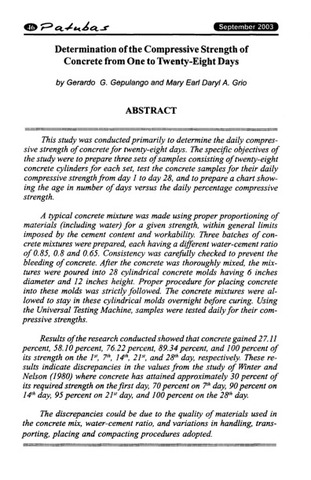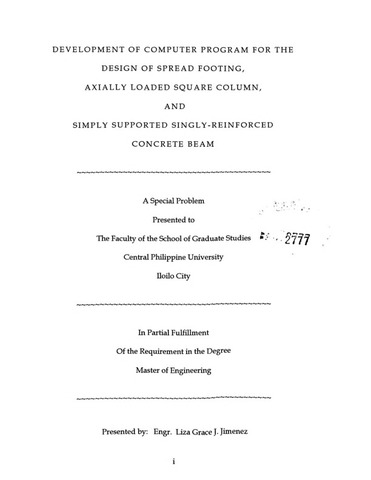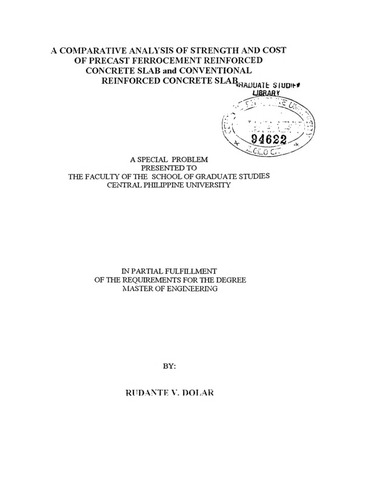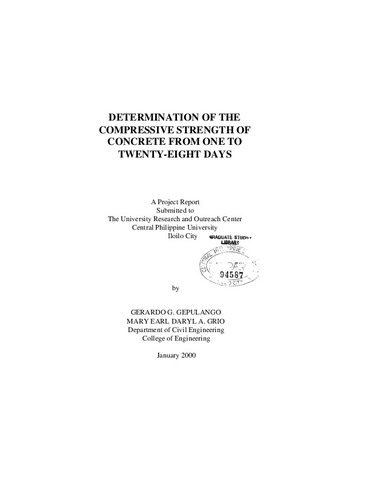Determination of the compressive strength of concrete from one to twenty-eight days
| dc.contributor.author | Gepulango, Gerardo G. | |
| dc.contributor.author | Grio, Mary Earl Daryl A. | |
| dc.date.accessioned | 2021-03-19T00:33:53Z | |
| dc.date.available | 2021-03-19T00:33:53Z | |
| dc.date.issued | 2003-09 | |
| dc.identifier.citation | Gepulango, G. G. & Grio, M. E. D. A. (2003). Determination of the compressive strength of concrete from one to twenty-eight days. Patubas, 1(1), 46-53. | en_US |
| dc.identifier.issn | 1908-515X | |
| dc.identifier.uri | https://hdl.handle.net/20.500.12852/614 | |
| dc.description | Journal article | en_US |
| dc.description.abstract | This study was conducted primarily to determine the daily compressive strength of concrete for twenty-eight days. The specific objectives of the study were to prepare three sets of samples consisting of twenty-eight concrete cylinders for each set, test the concrete samples for their daily compressive strength from day 1 to day 28, and to prepare a chart showing the age in number of days versus the daily percentage compressive strength. A typical concrete mixture was made using proper proportioning of materials (including water) for a given strength, within general limits imposed by the cement content and workability. Three batches of concrete mixtures were prepared, each having a different water-cement ratio of 0.85, 0.8 and 0.65. Consistency was carefully checked to prevent the bleeding of concrete. After the concrete was thoroughly mixed, the mixtures were poured into 28 cylindrical concrete molds having 6 inches diameter and 12 inches height. Proper procedure for placing concrete into these molds was strictly followed. The concrete mixtures were allowed to stay in these cylindrical molds overnight before curing. Using the Universal Testing Machine, samples were tested daily for their compressive strengths. Results of the research conducted showed that concrete gained 27.11 percent, 58.10 percent, 76.22 percent, 89.34 percent, and 100 percent of its strength on the 1st, 7th, 14th, 21st, and 28th day, respectively. These results indicate discrepancies in the values from the study of Winter and Nelson (1980) where concrete has attained approximately 30 percent of its required strength on the first day, 70 percent on 7th day, 90 percent on 14th day, 95 percent on 21s' day, and 100 percent on the 28th day. The discrepancies could be due to the quality of materials used in the concrete mix, water-cement ratio, and variations in handling, transporting, placing and compacting procedures adopted. | en_US |
| dc.language.iso | en | en_US |
| dc.publisher | Central Philippine University | en_US |
| dc.subject.lcsh | Concrete | en_US |
| dc.subject.lcsh | Concrete--Testing | en_US |
| dc.subject.lcsh | Concrete--Expansion and contraction | en_US |
| dc.subject.lcsh | Concrete construction | en_US |
| dc.title | Determination of the compressive strength of concrete from one to twenty-eight days | en_US |
| dc.title.alternative | Determination of the compressive strength of concrete from 1 to 28 days | en_US |
| dc.type | Article | en_US |
| dc.citation.firstpage | 46 | en_US |
| dc.citation.lastpage | 53 | en_US |
| dc.citation.journaltitle | Patubas | en_US |
| dc.citation.volume | 1 | en_US |
| dc.citation.issue | 1 | en_US |
| local.relation.associatedcontent | https://repository.cpu.edu.ph/handle/20.500.12852/938 Research report | en |
Files in this item
This item appears in the following Collection(s)
-
Journal articles [17]
-
Patubas [109]
Patubas is a refereed research journal of Central Philippine University.





